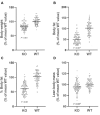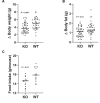Mice Lacking Gpr75 are Hypophagic and Thin
- PMID: 35023939
- PMCID: PMC8743382
- DOI: 10.2147/DMSO.S342799
Mice Lacking Gpr75 are Hypophagic and Thin
Abstract
Purpose: Humans with haploinsufficiency of GPR75, an orphan GPCR, are thin. Gpr75 knockout (KO) mice are also thin with improved glucose homeostasis. We wanted to confirm these findings in Gpr75 KO mice and determine whether decreased energy intake and/or increased energy expenditure contributed to the thin phenotype.
Methods: Gpr75 KO mice were generated by homologous recombination. All studies compared female and male Gpr75 KO mice to their wild type (WT) littermates. Body composition was measured by DXA and QMR technologies. Glucose homeostasis was evaluated by measuring glucose and insulin levels during oral glucose tolerance tests (OGTTs). Food intake was measured in group-housed mice. In singly housed mice, energy expenditure was measured in Oxymax indirect calorimetry chambers, and locomotor activity was measured in Oxymax and Photobeam Activity System chambers.
Results: In all 12 cohorts of adult female or male mice, Gpr75 KO mice had less body fat; pooled data showed that, compared to WT littermates (n = 103), Gpr75 KO mice (n = 118) had 49% less body fat and 4% less LBM (P < 0.001 for each). KO mice also had 8% less body fat at weaning (P < 0.05), and during the month after weaning as the thin phenotype became more exaggerated, Gpr75 KO mice ate significantly less than, but had energy expenditure and activity levels comparable to, their WT littermates. During OGTTs, Gpr75 KO mice showed improved glucose tolerance (glucose AUC 23% lower in females, P < 0.05, and 26% lower in males, P < 0.001), accompanied by significantly decreased insulin levels and significantly increased insulin sensitivity indices.
Conclusion: Gpr75 KO mice are thin at weaning, are hypophagic as the thin phenotype becomes more exaggerated, and exhibit improved glucose tolerance and insulin sensitivity as healthy-appearing adults. These results suggest that inhibiting GPR75 in obese humans may safely decrease energy intake and body fat while improving glucose tolerance and insulin sensitivity.
Keywords: diabetes; druggable; healthy thinness; insulin sensitivity; obesity.
© 2022 Powell et al.
Conflict of interest statement
All authors were employed by Lexicon Pharmaceuticals, Inc., at the time these studies were performed and may own common stock or may have been granted stock options or other equity incentive awards. The authors report no other conflicts of interest in this work.
Figures








References
LinkOut - more resources
Full Text Sources
Research Materials

